Recently, the world was transfixed by the news of a 57-year-old American, David Bennett – who underwent an experimental surgery at the University of Maryland Hospital. Terminally ill with heart failure and an irregular heartbeat that precluded him from receiving a heart transplant from a human donor, David underwent a nine-hour surgery in which his heart was replaced with a heart from a one-year-old, 240-pound genetically modified pig! Before the surgery he explained his decision: “It was either die or do this transplant. I know it’s a shot in the dark but it’s my last choice.”
Transplants from animals to humans (“xenotransplantation”) is not a new idea. The medical world has been working on this possibility for decades, realizing that developing the ability to use animal organs for transplants in humans may reduce or prevent the long waits for transplants. Without a solution, the problem will likely never be resolved – there will always be more patients in need of heart-lung transplants than donors.
A pig was chosen because the dimensions of its internal organs are similar to those of humans. But researchers still faced the significant obstacle of rejection of an organ, which is a risk in every transplant, including allotransplantation of human organs. For this reason, University of Maryland researchers used a pig that had been genetically modified so that its cells would not express specific antigens that the human immune system would recognize as foreign and lead to rejection.
From a Halachic standpoint, there is no issue with using a pig’s heart for a transplant – it is only prohibited to eat pork but not to benefit from pigs. Accepting a transplant is not the equivalent of eating. In any case, a patient needing a heart transplant is dangerously ill and Issurim would obviously be waived.
However, this
unprecedented case raises a basic question: Is it permissible to perform an
operation that places a patient in great danger if the chances of success are
unknown?
The Shevus Yaakov[1] (3:75) was asked to rule on a permissibility of performing a surgery on a patient with complex medical issues. He outlined several important conditions in order to permit it:
A question from an expert physician regarding a patient who is dangerously ill, and physicians say he will die within a day or two. However, they estimate that there is one treatment which may cure him, although it may produce the opposite result – in other words, if it is unsuccessful, God forbid, he will die within an hour or two. May one perform this treatment, or are we concerned about the patient’s “Chayei Sha’ah” (the short amount of time he has left to live) and it is therefore better to sit passively and do nothing?
The Shevus Yaakov introduces his response by stressing that questions of this sort require careful deliberation:
Since this is a case of life and death, one needs to be extremely deliberate with the question,
[examining]Shas and Poskim and raising all of the necessary questions. For one who causes the death of one soul among Yisrael is considered as if he has destroyed an entire world. Likewise, the opposite is true: one who [saves] one soul is as if he has upheld an entire world…
Following this important introduction, the Shevus Yaakov tackles the issue. He presents two sides to the question. On the one hand, if nothing is done, the patient can only hope for Chayei Sha’ah. On the other, even though an act that may kill somebody is generally prohibited, even if they will only live for a short time[2], but if it is intended as medical treatment, one may even desecrate Shabbos even if it will only extend his Chayei Sha’ah. (The Shevus Yaakov discusses this at length in Shu”t 1:13.) The question is whether one may risk Chayei Sha’ah in an attempt to procure Chayei Olam (a longer time to live)?
He adduces proof from the Gemara in Avoda Zara (27b) that it is essentially permissible: “Rava (some say Rav Chisda) said in the name of R’ Yochanan: If there is a doubt whether he will live or die, he should not be treated by a Nachri[3].” In other words, in a case where there is a doubt as to whether a patient is at risk of dying from his illness if it is untreated, he may not allow himself to be treated by a Nachri as we are concerned that the Nachri will murder him. But if he will certainly die if he is not treated, he may go to the Nachri for treatment because we are not certain that the Nachri will murder him but he will certainly die if he is not treated.
The Gemara asks: “But what about his Chayei Sha’ah?” In other words, even if he will certainly die if he is not treated, he will still live for a short while (i.e., Chayei Sha’ah). But if he allows a Nachri to treat him and he instead murders him, he has forfeited whatever remaining life he had. How is it permissible for him to place his Chayei Sha’ah at risk?
The Gemara answers: “We are not concerned about Chayei Sha’ah.” It is not prohibited to risk Chayei Sha’ah in order to try to attain Chayei Olam. Since the Nachri may cure him and help him achieve Chayei Olam, he may risk his Chayei Sha’ah.
Tosfos explain that the Gemara does not meant to discount Chayei Sha’ah. In fact, one may desecrate Shabbos even for possible Chayei Sha’ah. However, if a patient has the chance to attain Chayei Olam, we do not consider his definite Chayei Sha’ah to stand in the way.
The Shevus Yaakov notes that the Ramban (Toras haAdam) concurs with Tosfos, and the Shulchan Aruch rules accordingly (Y.D. 155:1). He therefore permitted the surgery in question. However, he makes several caveats:
Nevertheless, the physician should not do this [recklessly] – he should be very deliberate and discuss it with expert physicians in the city. He should conclude based on the majority opinion – a clear majority, namely that there are double [the number of people in favor than against]. This is because we are concerned about people taking the question lightly. Therefore, he should act based on the majority opinion and with the agreement of the Chacham in the city.
The Binyan Tzion[4] (111) also discusses this question. He cites the aforementioned Gemara in Avoda Zara that permits a patient to risk his Chayei Sha’ah in order to attain Chayei Olam. Then he discusses whether a Jewish doctor would be permitted to perform the treatment. He cites the Ramban (Toras haAdam, quoted by the Tur, Y.D. 336) who explains that when Chaza”l state, “And he shall surely heal – from here we derive that a physician has permission to heal”, they mean that “a physician should not say – why do I need this trouble? Perhaps I will make a mistake and accidentally kill somebody!” The Binyan Tzion proves from this statement that a Jewish doctor would be permitted to risk a patient’s Chayei Sha’ah in the course of medical treatment.
The Binyan Tzion then makes a remarkable statement. He asserts that if Pikuach Nefesh overrides the strict laws of Shabbos, whose abrogation are punishable by stoning, even though the patient may survive without treatment, “certainly we should permit a potential Issur of murder (which is punishable “merely” by beheading – a lighter form of death than stoning) if there is a possibility of Pikuach Nefesh.”[5]
The rulings of the Shevus Yaakov and Binyan Tzion are extremely novel. Though the surgery will place the patient in grave danger, nevertheless, since without it he can only expect Chayei Sha’ah, but it may help him attain Chayei Olam, it is within the mandate of a physician – “and he shall surely heal – from here we derive that a physician has permission to heal”.
However, the Poskim cite the Mishnas Chachamim (40) who argues that the Gemara in Avoda Zara only proves that a patient may risk his Chayei Sha’ah to attempt to attain Chayei Olam. There is no proof that a Jewish physician is permitted to carry out the treatment. The Mishnas Chachamim does not rule conclusively on this issue but he is inclined to say that a treatment or surgery is only permissible if there is an equal chance of success and failure. If there is a greater chance of death than survival, it is forbidden to discount his Chayei Sha’ah. He adds: “Regardless, on each occasion he should not proceed without the permission of Beis Din. He should not compare cases to one another because he can easily end up spilling blood.”
We should point out that the Binyan Tzion explicitly permits a Jewish physician to perform the surgery. The Achiezer (16:6) cites the Binyan Tzion’s ruling and adds that since the patient is a “Treifa” (in other words, he cannot live for much longer[6]), it is, in fact, more readily permissible for a Jewish physician to perform the surgery. A non-Jew is judged more strictly for killing a Treifa (he is liable to the death penalty – Rambam, Hilchos Melachim) than a Jew. The Achiezer concludes that since this is potentially lifesaving, concerns of Chayei Sha’ah may be discounted, and it is permissible for either a Jewish or non-Jewish physician to perform the procedure.
The Achiezer also disagrees with the conclusion of the Mishnas Chachamim that one may only permit the surgery if there is an equal chance of success and failure. He contends that the Gemara implies that the surgery is permissible regardless of the risk since without it the patient will certainly die. (HaGaon Rav Asher Weiss Shlit”a, in Shu”t Minchas Asher 1:115, maintains that the Halacha accords with the Achiezer.) However, he does conclude that “one should give the matter a great deal of thought and rely on the most expert physicians”.
As stated above, the Binyan Tzion emphasizes that the physician does not need to refrain out of fear that he will cause the patient’s death. He bases this on the Ramban’s opinion that the physician’s “permission to heal” frees him from the concern that he may accidentally cause a patient’s death. The Tzitz Eliezer (4:13) augments this with the following statement of the Ran: “Not only with bloodletting is there a possibility of causing death, but with any act of Refua one could say this. For they all pose a danger to the patient, for it is possible that the medication – if the physician has erred – will kill the patient.”
However, the Tzitz Eliezer notes that there is a considerable difference between the cases. The Ramban and Ran are discussing a “Refua Vada’is” – an act of Refua that has been proven effective. The concern is only that complications may arise due to the condition of the patient. In our case, the treatment itself may be dangerous. Nevertheless, the Tzitz Eliezer ultimately permits the surgery. He cites the Beis Meir (Y.D. 339) and Shevus Yaakov who permit it as well, and also discusses whether the patient’s suffering has any weight in the discussion.
In short, the view of the majority of the Poskim is that one may risk Chayei Sha’ah to attempt to attain Chayei Olam. However, this is only if expert physicians are consulted, and Beis Din grants permission.
In the case of Dave Bennett’s heart transplant, the surgery was only performed after approval by competent authorities, including the FDA. The transplant was not based solely on a single doctor’s hypothesis, but, rather, on many years of research, previous animal testing, and solidly reasoned medical theory that took into account possible risks and considered methods to mitigate them. Therefore, it certainly met the requirements set by the Poskim and was permissible.
As stated, a surgery this dangerous would only be permissible if the risk is only to a patient’s Chayei Sha’ah. If he has a chance of Chayei Olam without the surgery, it is prohibited for him to undergo such a risky procedure (though a Chacham should be consulted in each case). What constitutes Chayei Sha’ah in this regard?
Rashi in Avoda Zara (ibid.) appears to mention “a day or two” with regard to Chayei Sha’ah. However, the Achiezer (Y.D. 16) contends that Rashi would agree that Chayei Sha’ah can extend for several months. The Darchei Teshuva (155) cites various other opinions. The Chochmas Shlomo (Y.D. ibid.) and Igros Moshe (2:75) contend that the Shiur is twelve months, like the Shiur of a Treifa. However, haGaon Rav Asher Weiss Shlit”a (Minchas Asher ibid.) contends that these are “Divrei Nevius” (akin to prophecy without a sound Halachic basis) as the definition of Chayei Sha’ah and Treifa are not the same. He therefore concludes otherwise:
Rather it appears that there is no clear definition. If he is gradually deteriorating and will die within a timespan that people would consider to be a “short amount of time”, he is considered only to have Chayei Sha’ah. Practically speaking it would appear that we should consider six months [to be Chayei Sha’ah) as stated by the Achiezer, because I have seen medical studies that note that physicians’ estimation of probable death within six months, is extremely accurate. However, if they estimate that a patient will live for a year or longer, patients often survive for many more years.
Rav Asher concludes that even this determination is not conclusive and that “everything depends on the case and situation”.
Not only do the Poskim allow a patient to risk his Chayei Sha’ah for a chance of Chayei Olam, but they also permit even a Jewish physician to perform the surgery, because “permission is granted to a physician to heal”.[7] In the past, we have discussed whether a physician is permitted to refuse to perform a risky surgery when the Poskim have permitted it. It is well known that the “permission for a physician to heal” is in fact not voluntary – it is a Mitzva, as ruled by the Shulchan Aruch (Y.D. 336:1):
The Torah granted permission for a physician to heal – and it is a Mitzva and included in Pikuach Nefesh. If he refrains, he has spilled blood.
The Rambam also states (Peirush haMishnayos, Nedarim 4:4) that “a physician is obligated by Halacha to cure a Jewish patient”… ‘And you shall return it to him[8] – includes [restoring] his body (his health)’. If he sees him dying and is able to rescue him, he must rescue him with his body, money, or knowledge.”
The Ramban maintains that the obligation to save lives is also based on the Mitzva of “and your brother shall live with you” (Vayikra 25:36). If so, medical treatment in cases of Pikuach Nefesh also fulfills this Mitzva. In Toras haAdam (Sha’ar haSakana), the Ramban implies that there is yet another Scriptural source for the obligation to save lives – “v’Ahavta l’Rei’acha Kamocha” (Vayikra 19:18), as noted by the Tzitz Eliezer (5, Ramat Rachel, 21).
In short, a physician has an obligation to treat patients, at least those patients who are under his care. In a case where a patient’s life will be placed at risk by the treatment, we have concluded that he may undergo it if he is only risking Chayei Sha’ah. But may the physician refuse to perform it out of concern for the patient’s life, or even a concern about his reputation?
One could argue that he may refuse, as the surgery would not actually be considered an act of Refua. The patient’s acceptance of the risks and decision to proceed does not automatically give it the status of a “Refua”, since there is a strong chance that it will lead to his death. The fact that it may give him a chance to live longer than he would without the procedure is not sufficient to define it as an act of Refua.
This argument is bolstered by the consensus among the Poskim that the patient himself is not obligated to undergo the surgery. Despite the obligation to do everything he can to save his own life, this does not mean that he has to put himself into a situation that could lead to his immediate demise.[9]
If the patient is
not obligated to undergo the surgery, the physician is certainly not obligated
to perform it. The patient’s desire to proceed does not create an obligation
upon the physician. His obligation is only to provide Refua to others – not to accede to every wish of his patients.
[1] R’ Yaakov Reischer zt”l (1661-1733) of Austria.
[2] In fact, one may not do something even to a Goses (a person in the throes of death) which may hasten his demise (Shulchan Aruch Y.D. 339).
[3] [Editor’s note: The Meiri (ibid. 26a) elaborates that Chaza”l were referring to “primitive nations that were not refined in their religious practices and were devout worshippers of idols, celestial bodies, and talismans”, not the gentile nations in the era of the Rishonim. This most certainly does not apply today, and all references to Nachrim in this essay should be understood accordingly.]
[4] R’ Yaakov Etlinger zt”l (1798-1871) of Germany, author of Aruch laNer.
[5] He also adds that since the physician’s intention is to cure the patient, we may be even more lenient. He then raises the possibility of “Davar sheEino Miskavein” but concedes that his first argument is the main reason to permit the surgery.
[6] It is likely that this would be defined as a life expectancy of less than twelve months.
[7] Even those Poskim who do not agree with the application of this concept to our case concede that the surgery is permissible.
[8] Devarim 22:2
[9] This would be considered beyond the bounds of “Hishtadlus”, as stated by Rav Moshe Shternbuch Shlit”a (Shevilei haRefua 3, p111).














